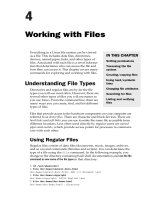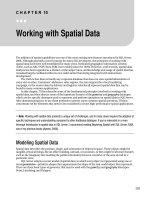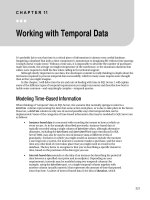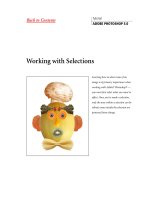Working with Arguments
Bạn đang xem bản rút gọn của tài liệu. Xem và tải ngay bản đầy đủ của tài liệu tại đây (112.82 KB, 12 trang )
C
onsider the following conversation:
“Junior, time to go to bed.”
“But why?”
“Because I said so!”
Only a parent can get away with giving the answer “because I said so.” But even parents sometimes have trou-
ble using this approach to make a convincing argument. It’s important to provide qualifiable reasons for asking
someone to accept a claim or take a certain action. Providing qualifiable reasons is the best way to support your
argument.
In the next three lessons, you’re going to learn about deductive arguments: what they are, how they work,
and how to recognize (and make) a good deductive argument—one that supports its assertions.
First, you need to know what deductive reasoning is. To help define it, the counterpart of deductive reason-
ing, which is inductive reasoning, will be introduced first.
LESSON
Working with
Arguments
LESSON SUMMARY
You hear arguments of all kinds throughout the day. In this lesson, you’ll
learn how to recognize the components of a deductive argument and
how it differs from an inductive argument.
7
53
Inductive Reasoning
When detectives arrive at the scene of a crime, the first
thing they do is look for clues that can help them piece
together what happened. A broken window, for example,
might suggest how a burglar entered or exited. Like-
wise, the fact that an intruder didn’t disturb anything
but a painting that hid a safe might suggest that the
burglar knew exactly where the safe was hidden. And
this, in turn, suggests that the burglar knew the victim.
The process described above is called inductive
reasoning. It consists of making observations and then
drawing conclusions based on those observations.
Like a detective, you use inductive reasoning all
the time in your daily life. You might notice, for exam-
ple, that every time you eat a hot dog with chili and
onions, you get a stomachache. Using inductive rea-
soning, you could logically conclude that the chili dogs
cause indigestion, and that you should probably stop
eating them. Similarly, you might notice that your cat
tries to scratch you every time you rub her stomach.
You could logically conclude that she does not like her
stomach rubbed. In both examples, what you’re doing
is moving from the specific—a particular observation—
to the general—a larger conclusion. Inductive reason-
ing starts from observation and evidence and leads to
a conclusion.
Using inductive reasoning generally involves the
following questions:
1. What have you observed? What evidence is
available?
2. What can you conclude from that evidence?
3. Is that conclusion logical?
We’ll come back to these questions in a later lesson. For
now, you know enough about inductive reasoning to
see how deductive reasoning differs from it.
Deductive Reasoning
Unlike inductive reasoning, which moves from specific
evidence to a general conclusion, deductive reasoning
does the opposite; it generally moves from a conclusion
to the evidence for that conclusion. In inductive rea-
soning, the conclusion has to be “figured out” and we
must determine whether or not the conclusion is valid.
In deductive reasoning, on the other hand, we start
with the conclusion and then see if the evidence for that
conclusion is valid. Generally, if the evidence is valid,
the conclusion it supports is valid as well. In other
words, deductive reasoning involves asking:
1. What is the conclusion?
2. What evidence supports it?
3. Is that evidence logical?
If you can answer yes to question 3, then the conclusion
should be logical and the argument sound.
It’s easy to confuse inductive and deductive rea-
soning, so here’s something to help you remember
which is which:
Inductive: Evidence • Conclusion (IEC)
Deductive: Conclusion • Evidence (DCE)
Inductive reasoning starts with the evidence and moves
to the conclusion. Deductive reasoning begins with
the conclusion and moves to the evidence for that con-
clusion. Here’s a memory trick to help you: You can
remember that the word Inductive begins with a vowel,
as does Evidence, so in inductive reasoning, you start
with the evidence. Deductive begins with a consonant,
and so does Conclusion, which is where you begin in
deductive reasoning.
In the field of logic, deductive reasoning includes
formal (mathematical or symbolic) logic such as syllo-
gisms and truth tables. Some practice with formal logic
will certainly sharpen your critical thinking and rea-
soning skills, but this book won’t cover that kind of
logic. Instead, we will continue to focus on informal
–
WORKING WITH ARGUMENTS
–
54
logic—that is, the kind of critical thinking and rea-
soning skills that help you solve problems, assess and
defend arguments, and make effective decisions in your
daily life.
The Parts of a Deductive
Argument
Lesson 2, “Problem-Solving Strategies,” talked about
the importance of identifying the main issue in order
to solve a problem. You learned to ask yourself, “What
is the real problem to be solved here?” Then you took
that problem and broke it down into its parts.
In looking at deductive arguments, you should
follow a similar process. First, you should identify the
conclusion. The conclusion is the main claim or point
the argument is trying to make. The various pieces of
evidence that support that conclusion are called prem-
ises. Keep in mind that an argument is not necessarily
a fight. In talking about inductive and deductive rea-
soning, an argument refers to a claim that is supported
by evidence. Whether or not that evidence is good is
another matter!
Identifying the conclusion is often more difficult
than you might expect, because conclusions can
sometimes seem like premises, and vice versa. Another
difficulty is that you’re used to thinking of conclusions
as coming at the end of something. But in deductive
arguments, the conclusion can appear anywhere.
Thus, when someone presents you with a deductive
argument, the first thing you should do is ask yourself:
“What is the main claim, or overall idea, that the
argument is trying to prove?”
In other words, just as a problem is often com-
posed of many parts, the conclusion in a deductive
argument is often composed of many premises. So it’s
important to keep in mind the “big picture.”
The Structure of Deductive
Arguments
The conclusion in a deductive argument can be sup-
ported by premises in two different ways. Say you have
an argument with three premises supporting the con-
clusion. In one type of deductive argument, each prem-
ise provides its own individual support for the
conclusion. That is, each premise alone is evidence for
that main claim. In the other type of argument, the
premises work together to support the conclusion.
That is, they work like a chain of ideas to support the
argument. These two types of arguments are repre-
sented as diagrams below.
Claim: assertion about the truth, existence,
or value of something
Argument:
a claim supported by evidence
Conclusion: the main claim or point in an
argument
Premises: pieces of evidence that support the
conclusion
–
WORKING WITH ARGUMENTS
–
55
Separate Support Chain of Support
conclusion
conclusion
↑
premise
↑
premise
premise premise premise
↑
premise
Here’s how these two structures might look in a
real argument:
Separate support: You shouldn’t take that job. The
pay is lousy, the hours are terrible, and there are no
benefits.
You shouldn’t take that job.
↑↑↑
Lousy Terrible No
pay hours benefits
Chain support: You shouldn’t take that job. The
pay is lousy, which will make it hard for you to pay
your bills, and that will make you unhappy.
You shouldn’t take that job.
↑
and that will make you unhappy
↑
which will make it hard for you to pay your bills
↑
the pay is lousy
Notice how in the second version, the entire argu-
ment builds upon one idea, the lousy pay, whereas in
the first, the argument is built upon three separate
ideas. Both, however, are equally logical.
Of course, an argument can have both separate
and chain support. We’ll see an example of that shortly.
What’s important now is to understand that when
premises depend upon each other, as they do in the
chain support structure, what we really have is a chain
of premises and conclusions. Look how the layers of a
chain support argument work:
Conclusion: It will be hard to pay your
bills.
Premise: The pay is lousy.
Conclusion: That will make you unhappy.
Premise: It will be hard to pay your
bills.
Premise: That will make you unhappy.
Overall conclusion: You shouldn’t take that job.
Because deductive arguments often work this
way, it’s very important to be able to distinguish the
overall conclusion from the conclusions that may be
used in the chain of support.
Identifying the Overall
Conclusion
Read the following sentences:
He’s tall, so he must be a good basketball player.
All tall people are good basketball players.
These two sentences represent a small deductive
argument. It’s not a particularly good argument, but it
is a good example of deductive structure. If these two
sentences are broken down into their parts, three dif-
ferent claims arise:
1. He’s tall.
2. He must be a good basketball player.
3. All tall people are good basketball players.
Now ask the key question: “What is this argument try-
ing to prove?” In other words, what is the conclusion?
Two clues should help you come up with the right
answer. First, look at which claims have support (evi-
dence) in this example. Is there anything here to sup-
port the claim that “He is tall”? No. Is there anything to
support the claim, “All tall people are good basketball
players”? No. But there are premises to support the
claim, “He must be a good basketball player.” Why
must he be a good basketball player? Because:
1. He is tall.
2. All tall people are good basketball players.
–
WORKING WITH ARGUMENTS
–
56
Therefore, the conclusion of this argument is:
“He must be a good basketball player.” That is what the
writer is trying to prove. The premises that support this
conclusion are “He is tall”and “All tall people are good
basketball players.”
A second clue in the conclusion that “He must be
a good basketball player” is the word so. Several key
words and phrases indicate that a conclusion will fol-
low. Similarly, certain words and phrases indicate that
a premise will follow:
Indicate a Conclusion: Indicate a Premise:
■
Accordingly
■
As indicated by
■
As a result
■
As shown by
■
Consequently
■
Because
■
Hence
■
For
■
It follows that
■
Given that
■
So
■
Inasmuch as
■
That’s why
■
Since
■
Therefore
■
The reason is that
■
This shows/means/
suggests that
■
Thus
Now, are the premises that support the conclusion,
“He must be a good basketball player,” separate support
or chain support?
You should be able to see that these premises
work together to support the conclusion. “He is tall”
alone doesn’t support the conclusion, and neither does
“All tall people are good basketball players.” But the two
premises together provide support for the conclusion.
Thus, the example is considered a chain of support
argument.
The Position of the Conclusion
While you might be used to thinking of the conclusion
as something that comes at the end, in a deductive
argument, the conclusion can appear in different
places. Here is the same argument rearranged in several
different ways:
■
He must be a good basketball player. After all, he’s
tall, and all tall people are good basketball players.
■
All tall people are good basketball players. Since
he’s tall, he must be a good basketball player.
■
He’s tall, and all tall people are good basketball
players. He must be a good basketball player.
■
He must be a good basketball player. After all, all
tall people are good basketball players, and he’s tall.
■
All tall people are good basketball players. He
must be a good basketball player because he’s tall.
In larger deductive arguments, especially the kind
found in articles and essays, the conclusion will often
be stated before any premises. But it’s important to
remember that the conclusion can appear anywhere in
the argument. The key is to keep in mind what the
argument as a whole is trying to prove.
One way to test that you’ve found the right con-
clusion is to use the “because”test. If you’ve chosen the
right claim, you should be able to put because between
it and all of the other premises. Thus:
He must be a good basketball player because
he’s tall and because all tall people are good
basketball players.
Practice
Read the following short arguments carefully. First,
separate the arguments into claims by putting a slash
mark (/) between each claim. Then, identify the claim
that represents the conclusion in each deductive argu-
ment by underlining that claim.
Example: We should go to the park. It’s a beautiful
day, and besides, I need some exercise.
W
e should go to the park. / It’s a beautiful
day / and besides, I need some exercise.
1. The roads are icy and it’s starting to snow heavily.
Stay in the guest bedroom tonight. You can leave
early in the morning.
–
WORKING WITH ARGUMENTS
–
57









